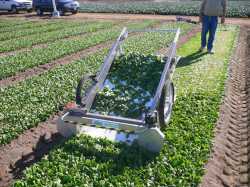Mechanical Harvesting For Leafy Greens

There’s not a grower in town who’s purchased one of Bob Sutton’s walk-behind HarvestStar baby leaf harvesters. In fact, there’s not a grower in California who’s bought one.
But that’s a reflection of the way they farm where Sutton Ag Enterprises is located, not a comment on the product’s quality. They don’t call Salinas, CA, “the nation’s salad bowl” for nothing. The state produces 90% of the nation’s leafy greens, so the HarvestStar is not nearly big enough for growers with thousands of acres who ship coast-to-coast, says Sutton.
“This can do 300 to 400 pounds of baby greens an hour,” he says. “The big ones here in Salinas do 4,000 pounds an hour.”
On the other hand, the HarvestStar only costs about $10,000. And while $10,000 may seem like a lot to a smaller grower, Sutton says there are many growers meeting the threshold where the unit pays off.
A rule of thumb for deciding on whether to buy is the length of the grower’s leafy greens season and how much produce is harvested. For example, if a grower harvests close to 1,000 pounds a week over a 12-week season and saves $1 per pound on labor, the unit pays for itself in a year. That’s a lot of leafy greens for a smaller grower who was formerly harvesting by hand, but Sutton says there must be quite a few out there.
“We’ve sold 12 this year,” he says, adding that they’d averaged just two or three annually in the five years since it was introduced. “For a company our size and in this market, that’s a big number.”
Loco For Local
Sutton says he thinks the leap in sales is due to changing consumer patterns, with more and more people wanting to buy food grown locally. It can be seen in the growth in farmer’s markets and Community Supported Agriculture across the country.
Furthermore, it’s easy to forget how young the large-scale leafy greens business is — before 2000 all leafy greens were hand-harvested, says Sutton. “When band blade technology came in they just took off, the market exploded, and the change was over night,” he says.
The typical HarvestStar buyer is often someone who used to do the labor himself, then hired part-time help as the business grew. But as labor costs keep growing too, these growers increasingly find themselves pulled away doing the farm marketing, etc. As everyone knows, a smaller grower wears a lot of hats.
Once saving on time and labor become a priority, they start looking for mechanical help. “Smaller operators don’t have enough time to do everything,” says Sutton, “and with this, what you used to do in five hours you can do in 20 minutes.”
Safe At Home
The mechanical harvester’s band blade also increases both quality and yield, says Sutton. Quality improves because the blade provides a consistent close cut, and there’s no hand compression of the leaves. Yield increases because the precision cut means you’re never leaving any produce behind.
The stainless-steel cutting head also helps ensure durability and food safety, with the latter a big concern these days. The big Salinas leafy greens growers were among the first of the nation’s vegetable growers to put together a tough voluntary food safety program. Sutton says the HarvestStar uses the same principles to ensure food safety.
“You cut it, it goes on a belt, and then it goes directly into a tote,” he says. “It works the same as the big machines — except you push it like a lawn mower.”









